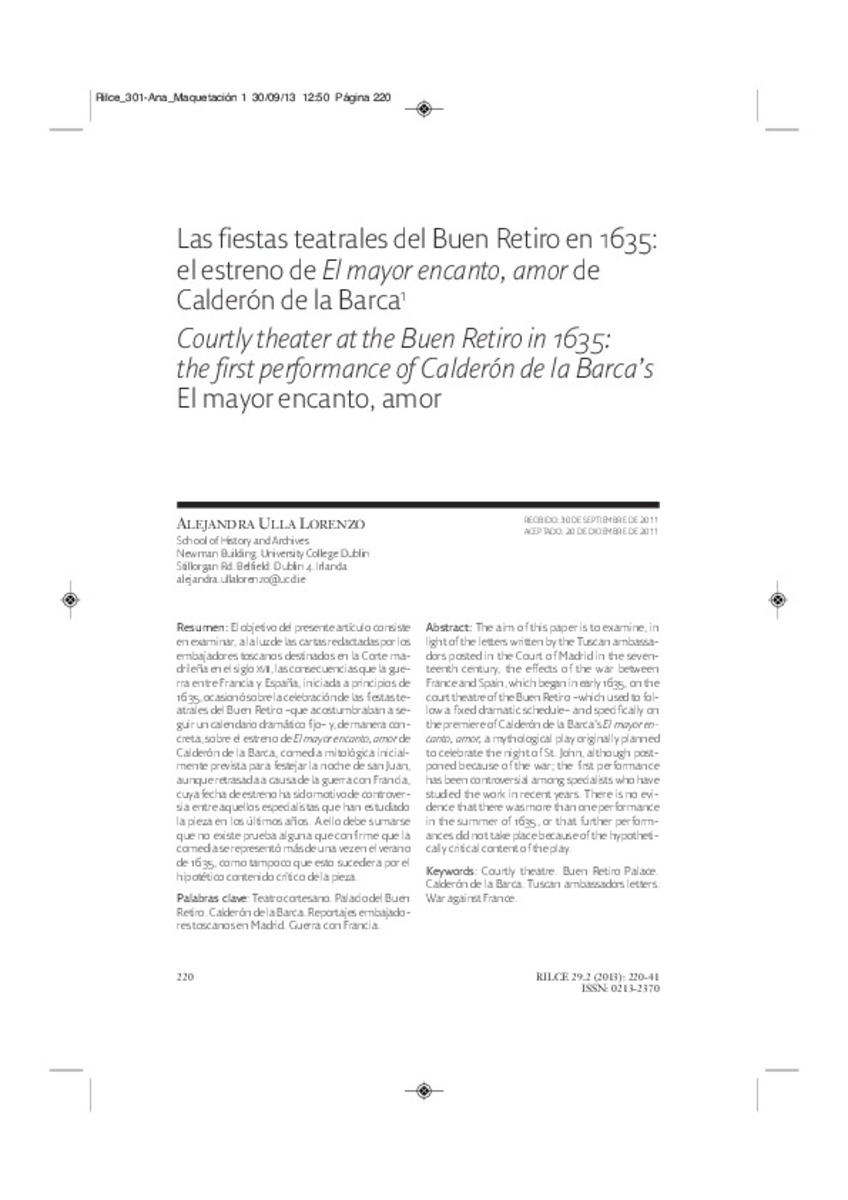Full metadata record
| DC Field | Value | Language |
|---|---|---|
| dc.creator | Ulla-Lorenzo, A. (Alejandra) | - |
| dc.date.accessioned | 2014-10-31T13:53:46Z | - |
| dc.date.available | 2014-10-31T13:53:46Z | - |
| dc.date.issued | 2014 | - |
| dc.identifier.citation | Ulla-Lorenzo, A. (2014). ""Las fiestas teatrales del Buen Retiro en 1635: el estreno de El mayor encanto, amor de Calderón de la Barca"", Rilce, vol. 30, n.1, pp. 220-241. | es_ES |
| dc.identifier.issn | 0213-2370 | - |
| dc.identifier.uri | https://hdl.handle.net/10171/37002 | - |
| dc.description.abstract | El objetivo del presente artículo consiste en examinar, a la luz de las cartas redactadas por los embajadores toscanos destinados en la Corte madrileña en el siglo XVII, las consecuencias que la guerra entre Francia y España, iniciada a principios de 1635, ocasionó sobre la celebración de las fiestas teatrales del Buen Retiro –que acostumbraban a seguir un calendario dramático fijo– y, de manera concreta, sobre el estreno de El mayor encanto, amor de Calderón de la Barca, comedia mitológica inicialmente prevista para festejar la noche de san Juan, aunque retrasada a causa de la guerra con Francia, cuya fecha de estreno ha sido motivo de controversia entre aquellos especialistas que han estudiado la pieza en los últimos años. A ello debe sumarse que no existe prueba alguna que confirme que la comedia se representó más de una vez en el verano de 1635, como tampoco que esto sucediera por el hipotético contenido crítico de la pieza. | es_ES |
| dc.description.abstract | The aim of this paper is to examine, in light of the letters written by the Tuscan ambassadors posted in the Court of Madrid in the seventeenth century, the effects of the war between France and Spain, which began in early 1635, on the court theatre of the Buen Retiro –which used to follow a fixed dramatic schedule– and specifically on the premiere of Calderón de la Barca’s El mayor encanto, amor, a mythological play originally planned to celebrate the night of St. John, although postponed because of the war; the first performance has been controversial among specialists who have studied the work in recent years. There is no evidence that there was more than one performance in the summer of 1635, or that further performances did not take place because of the hypothetically critical content of the play. | es_ES |
| dc.language.iso | spa | es_ES |
| dc.publisher | Servicio de Publicaciones de la Universidad de Navarra | es_ES |
| dc.rights | info:eu-repo/semantics/openAccess | es_ES |
| dc.subject | Teatro cortesano | es_ES |
| dc.subject | Palacio del Buen Retiro | es_ES |
| dc.subject | Calderón de la Barca | es_ES |
| dc.subject | Reportajes embajadores toscanos en Madrid | es_ES |
| dc.subject | Guerra con Francia | es_ES |
| dc.subject | Courtly theatre | es_ES |
| dc.subject | Buen Retiro Palace | es_ES |
| dc.subject | Tuscan ambassadors letters | es_ES |
| dc.subject | War against France | es_ES |
| dc.subject | Materias Investigacion::Filología y Literatura::Filología hispánica | es_ES |
| dc.title | Las fiestas teatrales del Buen Retiro en 1635: el estreno de El mayor encanto, amor de Calderón de la Barca | es_ES |
| dc.title.alternative | Courtly theater at the Buen Retiro in 1635: the first performance of Calderón de la Barca’s El mayor encanto, amor | es_ES |
| dc.type | info:eu-repo/semantics/article | es_ES |
| dc.relation.publisherversion | https://revistas.unav.edu/index.php/rilce/index | es_ES |
| dc.identifier.doi | 10.15581/008.30.311 | es_ES |
Files in This Item:
Statistics and impact
Items in Dadun are protected by copyright, with all rights reserved, unless otherwise indicated.






